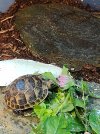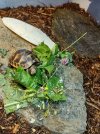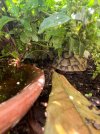Hello all!
My name is Maura, and my husband and I just adopted a Northern Ibera Greek baby who we named Olive. Olive came home this past Wednesday and seems to be settling in well.
Olive is currently living in a plastic tub that we just put inside the 5' x 2 1/2' tortoise table that he or she will grow into later. We also have plans to expand the table when Olive is big enough. Our light set up is on a pulley system to be lifted out of the way; the lid can also be lifted up by pulleys. We are also growing some tortoise food inside for Olive - spider plant, prayer plant, Boston Fern, broadleaf plantain, hosta, clover, and dandelion.
I can't thank the knowledgeable folks on this forum for helping us do the research over the last 6 months or so, especially the folks who have written such extensive care sheets. I hope we're on the right track.
Here are a few photos of our enclosure and of Olive.
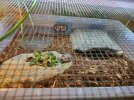

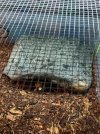
My name is Maura, and my husband and I just adopted a Northern Ibera Greek baby who we named Olive. Olive came home this past Wednesday and seems to be settling in well.
Olive is currently living in a plastic tub that we just put inside the 5' x 2 1/2' tortoise table that he or she will grow into later. We also have plans to expand the table when Olive is big enough. Our light set up is on a pulley system to be lifted out of the way; the lid can also be lifted up by pulleys. We are also growing some tortoise food inside for Olive - spider plant, prayer plant, Boston Fern, broadleaf plantain, hosta, clover, and dandelion.
I can't thank the knowledgeable folks on this forum for helping us do the research over the last 6 months or so, especially the folks who have written such extensive care sheets. I hope we're on the right track.
Here are a few photos of our enclosure and of Olive.




